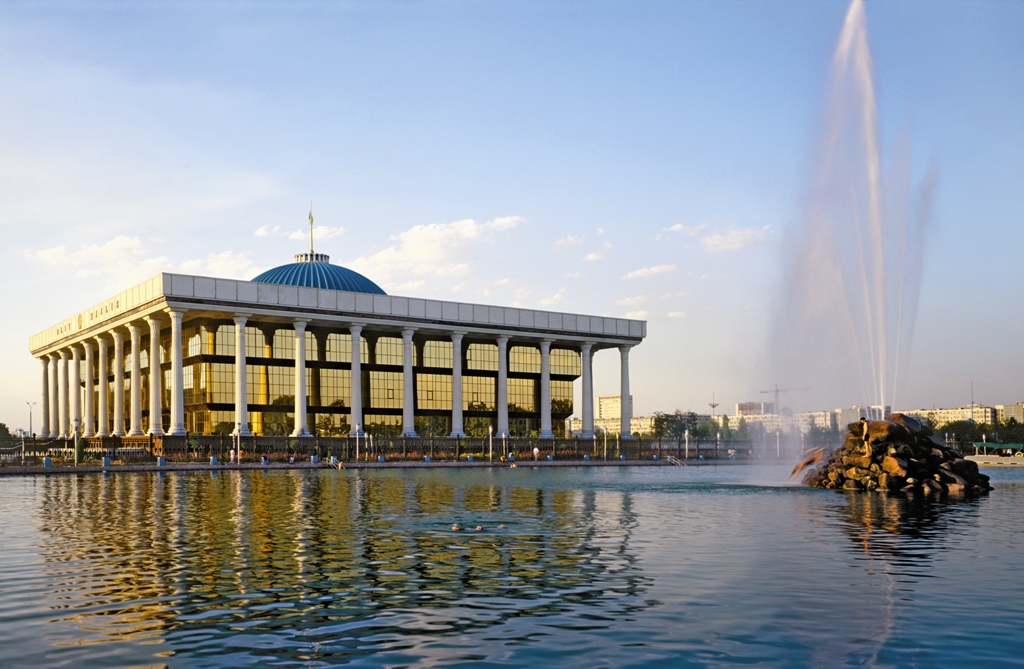On 31 August 1991 Uzbekistan attained real statehood - the most prominent event in the many centuries of the history of the Uzbek people. The exhibition complex ‘The Formation of the Sovereign Democratic State – the Republic of Uzbekistan’ displays documents laying the foundations of sovereignty, among which are the important Constitutional Law ‘On the Foundations of State Independence of the Republic of Uzbekistan’ and the Constitution of the Republic of Uzbekistan. Here also are presented the symbols of the independent state flag, crest and national anthem together with a map of the Republic of Uzbekistan. Also displayed are other important state foundation documents: Communication of the Supreme Soviet of Uzbekistan Concerning the Declaration of Independence on 31 August 1991; ‘Decree of the Supreme Soviet of Uzbekistan Concerning the Proclamation of the Sovereign State of Uzbekistan’; ‘On the Flag of the Republic of Uzbekistan’; ‘On the Crest of the Republic of Uzbekistan’ and ‘On the Hymn (National Anthem) of the Republic of Uzbekistan’. Also exhibited is the musical score of the National Anthem of the Republic of Uzbekistan by the composer Mutal Burkhanov. As symbols of the state there are also exhibited national orders and medals which have been established in the period of Independence. Great attention is allotted to exhibits demonstrating the strengthening of the defense of the republic and the enormous role of Uzbekistan in the struggle against international terrorism. Among the exhibits are photographs of soldiers and officers killed during the liquidation of terrorist bands and of weapons used by terrorists.

External Policies
The exhibition complex dedicated to the internal political activities of the Republic of Uzbekistan is one of the most detailed. Documents and other materials introduce the manner Uzbekistan in which is building its internal policies based on the principals of equal rights, mutual benefit and non-interference in the internal affairs of other countries. Today Uzbekistan is recognised by more than 165 states, with 130 of whom diplomatic relations have been established. In the capital of the republic the embassies of 35 countries operate, including those of such world powers as the USA, Japan, Germany, Great Britain, France, China and Russia. In 1992 the Republic of Uzbekistan became a member of the United Nations and in 1993 became a member of UNESCO and a member of the OSCE Parliamentary Assembly. Uzbekistan actively participates in summits of NATO, of the Commonwealth of Independent States and of the states of Central Asia, etc.
Economics
One of the sub-sections of the exhibition is dedicated to the economic policies of Uzbekistan, its theoretical basis and the implementation of such policies and approaches in the economic life of its people. A map of Uzbekistan shows the distribution of the nation’s rich natural resources. In minerals the republic occupies a leading position in terms of the world’s reserves and output: fourth place in gold reserves (seventh in terms of level of output), eleventh in copper reserves and eighth in reserves of uranium. Uzbekistan produces the purest gold in the world. Among the numerous exhibits representing the leading branches of industry in Uzbekistan are examples of the products of the Bukhara and Ferghana oil refineries, unique articles made from Uzbek precious stones, a display of the Kokdumalak gas deposit, models of new automobiles, modern air craft and products of the Fonton factory. There is also a display devoted to the development of the medical and pharmaceutical industry. Agricultural reforms and the achievements of the country in grain self sufficiency are demonstrated through a complex of photographs, documents, examples of agricultural production, etc. This section of the museum also reflects the status of the contemporary development of air, railway and automobile transport in Uzbekistan.
Education, Science and Culture
In this section are displayed photographs, documents and other materials relating to splendid activities in Uzbek science and culture. Exhibited are instructions of the Uzbek President for the award of the order ‘Buyuk Khizmatlari Uchun’ to prominent scientists, writers, composers, artists and actors. The exhibit demonstrates that in the goals of the long term development of the nation’s intellectual potential great attention is being given to educational reform and the direction of the professional preparation and upbringing of the growing generation. The exhibition also illuminates the country’s scientific achievements.
Today Uzbekistan has strong scientific centres with a developed research and material base, a broad spectrum of scientific achievement and qualified personnel. The results of scientific research find their practical application in many spheres of life and serve as the basis for the acceleration of economic and social progress. Legislation concerning education and the national programme for the preparation of bodies of specialists provides for, apart from secondary level studies, professional or academic tertiary education (for an obligatory three years). Tertiary education in Uzbekistan now has two levels (baccalaureate and masters) while post-tertiary also has two (aspirant and doctorate).
Sport
Significant attention is given in this section of the exhibition to the development of mass and professional sport in the country. Numerous awards and medals won in Olympic, World and Asian Game championships attest to the successes of Uzbekistan’s sportsmen and women in such kinds of sports as kurash, tennis, boxing, volley ball and chess. Also displayed are colour images of the unique architectural monuments of Uzbekistan, of the 2,500th anniversary celebrations of Khiva and Bukhara and of theatrical presentations adjacent to enormous photographic panels with views of major modern public and commercial buildings. Exhibits relating to theatres, museums and other establishments built in the years of independence complete this section of the exhibition.
For a Healthy Generation
A separate section is dedicated to the activity of the social organization Soglom Avlod Uchun, formed to assist in the realisation of a national maternity and childhood health support programme